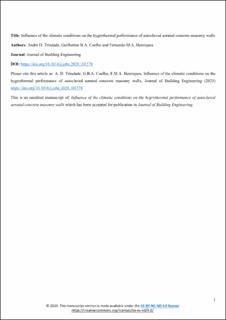| dc.contributor.author | Trindade, André D. | |
| dc.contributor.author | Coelho, Guilherme Barreto Arez | |
| dc.contributor.author | Henriques, Fernando M.A. | |
| dc.date.accessioned | 2023-02-14T09:16:31Z | |
| dc.date.available | 2023-02-14T09:16:31Z | |
| dc.date.created | 2022-10-10T11:39:19Z | |
| dc.date.issued | 2020-06-24 | |
| dc.identifier.issn | 2352-7102 | |
| dc.identifier.uri | https://hdl.handle.net/11250/3050605 | |
| dc.description.abstract | The energy performance of buildings has undergone major developments over the last few years. Due to increasingly demanding regulations, new technologies and constructive solutions have been sought to make buildings more energy efficient. Autoclaved aerated concrete (AAC) is a sustainable building material that provides a suitable solution to this problem. However, the hygrothermal behavior of AAC masonry walls is the subject of little discussion throughout the scientific community. The paper focuses on identifying the influence of climatic conditions, as well as the effect of surface layers or insulation systems on the hygrothermal performance of exterior walls made of AAC. For the purpose of this study, several constructive solutions were analyzed in different climatic settings, namely Munich, Germany; Stockholm, Sweden; and San Francisco, U. S. A. The effects of applying different types of render/plaster layers or external thermal insulation system on AAC walls was also determined using hygrothermal software. In addition, the damage potential of frost and rainwater were assessed to better comprehend how these walls behave. The results showed that the overall performance of AAC wall systems and frost damage potential was found to be greatly influenced by the hygric properties of the exterior render. Additionally, it was shown that calculating the thermal transmittance in steady-state conditions can lead to gross underestimations compared to transient models. The results indicate that the EPS and XPS insulated walls were susceptible to moisture increase, due to rainwater leakage, unlike the MW insulated wall, which dried significantly faster. | en_US |
| dc.language.iso | eng | en_US |
| dc.publisher | Elsevier | en_US |
| dc.relation.ispartofseries | Journal of Building Engineering;Volume 33, January 2021, 101578 | |
| dc.rights | Attribution-NonCommercial-NoDerivatives 4.0 Internasjonal | * |
| dc.rights.uri | http://creativecommons.org/licenses/by-nc-nd/4.0/deed.no | * |
| dc.subject | Computational simulation | en_US |
| dc.subject | Autoclaved aerated concrete | en_US |
| dc.subject | Thermal transmittance | en_US |
| dc.subject | Hygrothermal performances | en_US |
| dc.subject | Frost damage | en_US |
| dc.title | Influence of the climatic conditions on the hygrothermal performance of autoclaved aerated concrete masonry walls | en_US |
| dc.type | Peer reviewed | en_US |
| dc.type | Journal article | en_US |
| dc.description.version | acceptedVersion | en_US |
| dc.source.articlenumber | 101578 | en_US |
| cristin.ispublished | true | |
| cristin.fulltext | postprint | |
| cristin.qualitycode | 1 | |
| dc.identifier.doi | https://doi.org/10.1016/j.jobe.2020.101578 | |
| dc.identifier.cristin | 2060010 | |
| dc.source.journal | Journal of Building Engineering | en_US |
| dc.source.volume | 33 | en_US |
| dc.source.issue | 33 | en_US |
| dc.source.pagenumber | 22 | en_US |

